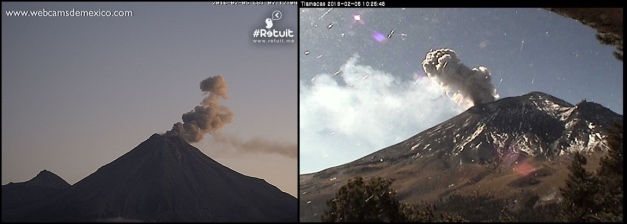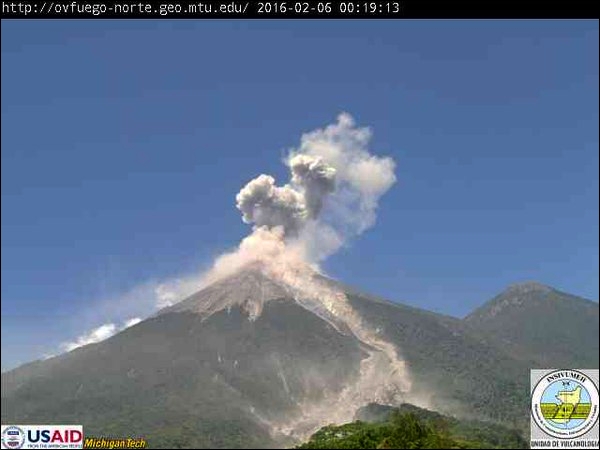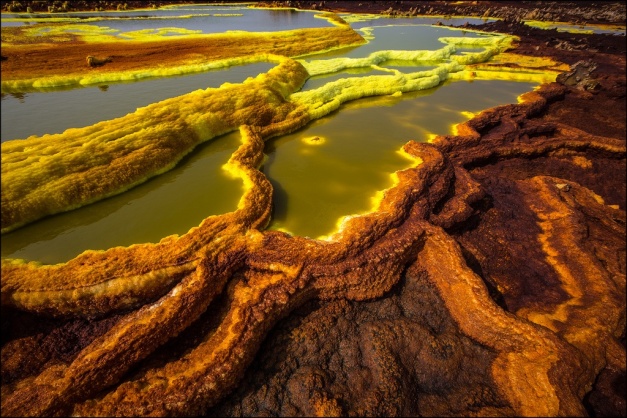There was so much on the volcano news today that we thought it’s enough stuff for a post just on volcano news. Here you go:
Japan, Sakurajima: after the volcano had taken nearly five months off it was back to usual procedure today with a big bang. It seems there was only that one mighty blast and the volcano went quiet again.
In Mexico, both Fuego del Colima (left) and Popocatepetl (right) are working hard on the destruction of their lava domes:
Guatemala: One of the stronger explosions with pyroclastic flow(s) occurred in Santiaguito (Photo left: Prensa Libre; middle: Chay Antonio; right: NASA). Some nearby communities had to be evacuated. A MODIS Terra satellite image shows the ash cloud from space:
Also, Fuego went back to higher activity after a quiet week or so.
Nicaragua‘s Momotombo still shows a nightly glow, the various vents at the crater lining up like a necklace. By day one can see that neither Momotombo’s constant gas plume nor the brush fires on its slopes are doing air quality any good. (webcams INETER)

Reventador in Ecuador is very busy again, causing several hot spots in the MODVOLC thermal image of the last 2 days:
 In Chile, Copahue is constantly blasting out copious amounts of ash over its surroundings. I wonder when it will decide to go for a real eruption?
In Chile, Copahue is constantly blasting out copious amounts of ash over its surroundings. I wonder when it will decide to go for a real eruption?
Also, Nevados de Chillán goes on emitting ash from the old and from a new crater that had opened on January 8th. Left image from 1 Febr., right one from today, 5 Febr. (webcam Portezuela, SERNAGEOMIN)
Not volcano, but… a very strong earthquake M6.4 or 6.7 at ~20 km depth hit south-west Taiwan, with much damage in Gaoshu and other nearby communities. Horrible pictures of collapsed buildings appear on the internet; so far reported are 2 fatalities, 127 wounded hospitalized, more than 300 families homeless, but to believe there were no more is probably just wishful thinking… Liquefaction has been mentioned but no details so far.
Last but not least I would like to recommend a good read on the “volcano” that isn’t a volcano – Dallol of northern Afar (Ethiopia) – by Culture Volcan
There has been much more happening today in the volcano world, those events I have mentioned above just came my way and I passed them on to you. Have a great weekend!
Enjoy! – GRANYIA











Thank you Granyia for this extensive summary. I have been away for 2 weeks, just what I needed to see what I had missed.
Unfortunately I went to a craton region, not a single volcanic cone on sight……
Thanks again.
LikeLike
Thanks dfm! Depends on what craton you have been on, you may not have looked deep enough? 😉
This really is a volcanically busy weekend, here are some more updates:
I had been too tired yesterday to follow up the first reports on Soputan’s activity in Sulawesi. It has evolved to a quite remarkable eruption with plumes going 7km high and aviation color code red, pyroclastic flows and lava streams. Too bad that there is no webcam avaible… but what is worse (and critizised on twitter) is that the local government has not so far provided any sort of protection like masks and shelters to the affected population! This photo is making the rounds today, and beside it is the latest thermal hot spot image from MODVOLC:
~~~
Sadly, the death toll in the Taiwan earthquake has risen to 24, with over 500 injured. Taiwan government stated last night that 132 people are still buried in the collapsed 17-storey apartment towers – rescuers say that they may be able to reach only 29… There is an investigation ongoing whether empty oil cans built into the walls of the building may have contributed to its collapse or have been used as a light-weight filler for non-weight-bearing walls. This isn’t the only building that came down on Saturday in Tainan City; nine others collapsed and five are tilted at an angle. (http://mashable.com/2016/02/07/taiwan-earthquake-oil-cans/?utm_cid=mash-com-Tw-main-link#2WD5RgdMcgq3)
Here is an 11 min. video showing the extent of the damage and the difficulties of the rescue efforts: https://www.youtube.com/watch?v=PAsy84B82zE
~~~
Santiaguito (flank crater of volcan Santa Maria, Guatemala) is going from bad to worse today with more pyroclastic flows and tons of ash pestering the residents around it (photo via twitter, @monik_vm):
~~~
A photo by Øystein L. Andersen from today shows that Bromo in East Java is still going strong:
“Bromo volcano. 7th February. Explosive eruption pre-accompanied by shockwave.”
~~~
Sherine tweeted a link to the report on the last Sakurajima paroxism. A helicopter survey was carried out and the report published yesterday, also containing images from the last overflight in Dec. 2015 for comparison. What I could glean from the translation was that:
– there were no obvious changes in the Showa crater, exept for a steady small steam plume (~30m)
– thermal images showed increased heat area in the crater as could be expected, but no obvious changes in other areas
– the explosion coincided with a volcanic earthquake, but seismic activity diminished after it
– the eruption plume was 2200m high, SE trending for 13km; pyroclasts scattered around for 1300m.
– SO2 measurement results were low at 100t/d
– Aira caldera area: Inflation had been going on until mid-August 2015, but turned to deflation until end of last year. This January it stagnated.
Test your Japanese skills! 😉
Click to access 20160206_506.pdf
LikeLike
Re: my note on Momotombo in the post above: I have been wondering about those “brushfires” (who in their right mind would do grassland management on an erupting volcano? – or, for how long would an accidental brushfire burn in the same area?). Found the explanation on the INETER website in their report of February 2, 2016 – “In new observations made by the specialist team Volcanology INETER confirm the existence of cracks in the southern and southeastern flank of the volcano, where there were small amounts of lava oozing out during the explosions recorded last weekend, glowing at night. This type of cracks on the flanks of Momotombo have happened on several occasions during past eruptions. Activity of this volcano remains micro-seismic. The seismic amplitude (MARS) remains in low or moderate values between 150 and 480 units.” There we have our “…high mountain summit which always has several chimneys smoke” which Velasco described in 1580 (and I mentioned in my last post).
~~~
About Masaya, the report says: “”Volcanic tremor remained as a result of strong movement of magma below Masaya caldera. The gases emanating from the Santiago crater have such a high temperature (600 to 800°C) that they show overnight incandescence from several kilometers distance. The possibility of explosions in the Santiago crater remains; emissions of gases, ash and fragments of hot rocks and lava have been recorded. The seismic amplitude (MARS) was in moderate to high values from 100 to 550 units.”
webcams: http://volcams.malinpebbles.com/pubweb/C-Amerika.htm#NC
LikeLike
Momotombo flank incandescent points:
LikeLike
This is amazing to watch… the cracks are already visible in late afternoon… and better in the dark… (http://web-geofisica.ineter.gob.ni/webcam/v_momotombo3/mostrar.html)
LikeLike